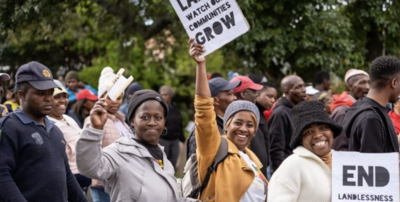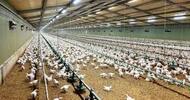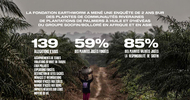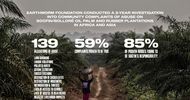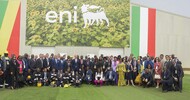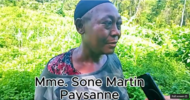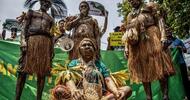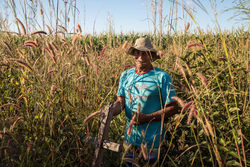
In the heart of soy monocultures is a graveyard belonging to one of the local communities, driven off the land by the Campos Lindos project. Zé Batata, a subsistence farmer who lives in Campos Lindos, Tocantins, Brazil, stands by the grave of his mother which has been covered entirely by corn. (Photo by Thomas Bauer)
Connect the dots: Cerrado soy drives inequality to provide EU with chicken
BY ANNA SOPHIE GROSS ON 19 SEPTEMBER 2018
This is the fourth in a series by journalist Anna Sophie Gross who traveled to the Brazilian states of Tocantins and Maranhão in Legal Amazonia for Mongabay to assess the impacts of agribusiness on the region’s environment and people.
CAMPOS LINDOS, Brazil — Seu Raimundo de Miranda used to grow rice, beans and cassava with his wife, Brigida, on a smallholding in the rural countryside of Tocantins state in Brazil. His life there was gratifying, simple and self-reliant: living off the animals he raised and crops he planted, and dependent on almost nothing from the outside world.
Many families in the surrounding area lived by similar sustainable means. Most had been on the land for nearly a century, though none held official land titles.
Twenty years ago, things began to change as agricultural entrepreneurs started arriving from the south of the country to the north of Tocantins, dubbed the agricultural “filet mignon” of the Cerrado. Much of the untitled land that Seu Raimundo and other members of the traditional community had used to cultivate crops, raise cattle and bury their dead was claimed for industrial agribusiness production, taken over by huge soy monocultures.
For Seu Raimundo, the most painful impact of this usurpation came in the form of health declines: regular and severe bouts of pesticide intoxication suffered by his family. (The industrial model for growing soy requires massive doses of herbicides, often sprayed from planes.) Two of Seu Raimundo’s nephews were hospitalized and eventually died of pesticide poisoning. Inquests followed, but no verdict ever came. Seu Raimundo’s wife also became severely ill.
Deprived of its livelihood and health, the family sold its land in 2014 for less than it was worth and moved to the city of Campos Lindos, an urban center newly built to cater to the needs of the soy boom, and also a place infamous across Brazil for its high levels of poverty and dire living conditions.
“We’re producing a lot less, we’re persecuted, and locals from the city steal from us,” Seu Raimundo tells Mongabay. “It’s not easy at all.”
In the late 1990s, shortly after the state of Tocantins was created, local mayor Siqueira Campos (after whom the new city was named) began dividing up and selling untitled land plots to moneyed would-be agribusiness entrepreneurs, many of them his friends from the south of Brazil. The land was sold with neither the acknowledgment of the families already residing on it, nor recognition of their many-decades-old claims to plots utilized for subsistence farming and livestock grazing.
The rise of Campos Lindos
In the late 1990s, shortly after the state of Tocantins was created, local mayor Siqueira Campos (after whom the new city was named) began dividing up and selling untitled land plots to moneyed would-be agribusiness entrepreneurs, many of them his friends from the south of Brazil. The land was sold with neither the acknowledgment of the families already residing on it, nor recognition of their many-decades-old claims to plots utilized for subsistence farming and livestock grazing.
So began what is today called the Campos Lindos project.
The legal paperwork legitimizing these new landowners said they would plant fruit trees. Thirty years on, there is not a fruit tree in sight, only soy and corn as far as the eye can see.
The traditional subsistence farmers didn’t take what they saw as land theft lying down. After decades of local campaigns, supported by the Pastoral Land Commission (CPT), an NGO, some of those who lived on the land where the Campos Lindos project was being built received land titles from the government; 70 were granted in total.
Events at Campos Lindos have been replicated across the Brazilian Cerrado in recent decades. The shift in land use became possible some 30 years ago when semi-arid savanna, long deemed barren, worthless and unprofitable, was reassessed by wealthy rural elites who realized that new technological advances made this land valuable for arable plantations. With that discovery, entrepreneurs rushed in, first to Mato Grosso state, much of which is in the Amazon biome, and then to Brazil’s newest agricultural frontier, the Cerrado biome. Particularly attractive there was the Matopiba region, a name concocted by agribusiness that incorporates the first letters of the states of Maranhão, Tocantins, Piauí and Bahia, where today soy is king.
Traditional people fight back
The traditional subsistence farmers didn’t take what they saw as land theft lying down. After decades of local campaigns, supported by the Pastoral Land Commission (CPT), an NGO, some of those who lived on the land where the Campos Lindos project was being built received land titles from the government; 70 were granted in total.
But many more were left out. In some cases, parents and their offspring were considered by the government as one family unit, and awarded just one title, when in fact they had each owned and worked separate land plots.
In 2004, the Associação Planalto, the organization that represented all of the wealthy plantation owners in Campos Lindos, launched a legal case, first accusing six, and then 42 poor, rural families of having invaded their territory and stolen their land.
During the decade-long court case, many families gave up the fight and moved to the outskirts of the city, where today, deprived of their subsistence livelihoods, they struggle to get by in impoverished, crime-ridden neighborhoods.
This case is emblematic of land conflicts now raging across Matopiba, where levels of violence have steadily marched upward; 70 people were killed in land dispute-related attacks in 2017, up from 61 in 2016 and 29 in 2011, according to data collected by the CPT.
Conflict over ‘legal reserves’
Traditional people say the large landowners have even turned Brazil’s environmental protection laws against them. According to Brazil’s recently upheld 2012 Forest Code, anyone living within certain parts of the Cerrado must maintain 20 to 35 percent of their property in its natural state in perpetuity, as a “legal reserve.” Large-scale growers who have failed to meet this threshold have increasingly laid claim to the Cerrado’s remaining natural lands to serve as the legal reserve for their vast soy plantations.
“I feel insecure; I can’t say that I’m going to be here for the rest of my life,” says João Ramos dos Reis, president of the syndicate of traditional rural workers. “I wish that I could say that this territory here will be for my grandchildren.”
Conflict over ‘legal reserves’
Traditional people say the large landowners have even turned Brazil’s environmental protection laws against them. According to Brazil’s recently upheld 2012 Forest Code, anyone living within certain parts of the Cerrado must maintain 20 to 35 percent of their property in its natural state in perpetuity, as a “legal reserve.” Large-scale growers who have failed to meet this threshold have increasingly laid claim to the Cerrado’s remaining natural lands to serve as the legal reserve for their vast soy plantations.
It also just so happens that these remaining natural lands are often already held, without title, by traditional communities who collectively use them for small-scale planting, grazing or building. A legal reserve designation automatically restricts those activities, so once again, traditional people are deprived of livelihoods, squeezed out of rural areas, and forced to emigrate to urban Campos Lindos.
In the case of the Associação Planalto lawsuit, the land on which the remaining subsistence farmers live was officially declared the association’s legal reserve: a Pyrrhic victory that allows the traditional people to remain on the land without titles, but bars them from farming or earning money on it. Activists have dubbed the legal reserve gambit “green land-grabbing.”
A disenfranchised people
“I feel insecure; I can’t say that I’m going to be here for the rest of my life,” says João Ramos dos Reis, president of the syndicate of traditional rural workers. “I wish that I could say that this territory here will be for my grandchildren.”
Not only does João Ramos suffer from land insecurity; he has also been denied his traditional livelihood. Much of the area where he used to raise cows has been planted with soy. “I almost cried when I last went up there,” he says.
His parents had lived on the river floodplain, but they sold their land cheaply to a large-scale landowner and moved to Campos Lindos because their small-scale cattle raising operation had become untenable. In the wet season, pesticide-ridden agricultural runoff polluted the stream from which their cows drank, causing the animals to miscarry.
João Ramos is fighting on, planting vegetables and pulses (beans, peas and lentils which can be dried).
“You can’t take an illiterate country guy like me and expect them to live well in the city,” João Ramos says. “I’d probably start robbing from the supermarket.”
Many more traditional people, including Seu Raimundo de Miranda, gave up the fight for their rural land and now live on the outskirts of Campos Lindos, members of the urban poor.
The trickle-down myth
Many soy growers, and state and federal politicians, justify the rapid conversion of rural traditional subsistence communities into gigantic soy plantations as a form of trickle-down economics. They say it generates wealth, improved infrastructure, and jobs.
Campos Lindos, a city surrounded by soy plantations, stands in dire contrast to those claims. Wealth in this soy-scape is highly concentrated in the “Ninhos de Gaucho” (Southerners’ Nests): mansions situated at the heart of the plantations, each encircled by a protective shield of high trees and owned by soy moguls, almost all of them transplanted from Brazil’s south.
Elsewhere, poverty reigns. Campos Lindos has a prosperity rating of 50.54, 10 points below the Tocantins state average, and 17 points below the national average, according to the social progress index, an economic tool developed by the Amazonian Institute of Man and Environment (Imazon).
According to the tool, the municipality scores particularly low on “basic human necessities,” such as clean water and sanitation, living conditions, and access to education. It also has high levels of maternal death at childbirth, as well as high infant mortality.
Legal Amazonia, a socio-geographic division that includes all of the Amazon biome and parts of the Cerrado, contains 72 municipalities. Only 13 of these meet the national average in terms of social development, in spite of huge investments throughout the region in mining, ranching and soy farming. While Brazil ranks 43rd in the world in the Social Progress Index, Legal Amazonia, if it was taken alone, would rank 94th.
“There are some municipalities which are doing reasonably well — partly as a result of agricultural expansion — but they are still massively lagging behind the rest of the country,” says Beto Verissimo, a senior researcher at Imazon. “Soy expansion creates a lot of wealth but only for 1 percent of the population.”
Seu Raimundo de Miranda is part of that remaining 99 percent. In the ’90s, he did a short stint helping to deforest the Cerrado. He worked for a large-scale soy grower, cutting down trees and digging out roots to make way for cattle, which leveled out the land in preparation for its conversion to soy. The work was backbreaking, undocumented, and paid very poorly.
It was also temporary. Once the land was deforested and planted with soy, Miranda was no longer needed and never called back.
“People like me aren’t wanted for the day-to-day running of the soy farms,” he says. “They need specialized workers who can operate machines, which means that locals from around here can’t work there.”
The future offers little hope of agribusiness jobs. According to the Brazilian Institute of Geography and Statistics (IBGE), Brazil currently has 15 million agricultural workers. But that’s 9.2 percent less than in 2006: a loss of 1.5 million, mostly rural, jobs in slightly more than 10 years. The main reason is mechanization of the plantations; the number of tractors registered on rural properties increased by 49.7 percent over the same period.
Many Matopiba landowners bring in workers from elsewhere to operate the complex machinery, often from their own southern states, leaving traditional local people with no long-term job prospects and without the capacity to live sustainably off what had been their land.
Colonizing the Cerrado
José Antonio Gorgen, commonly known as Zezão, is one of the best-known soy growers in Matopiba, with huge farms spread across Maranhão and Piauí. He represents the views of many plantation owners and agriculturalists when he says the influx into Matopiba of southerners, of which he is one, was an extremely positive advance for the local population.
“If we hadn’t come from the south, this land would be empty today,” he tells Mongabay. He says there is just one large-scale soy grower in all of Maranhão who is originally from the state, while there are no native soy producers in Piauí state.
According to Zezão, the subsistence farming techniques practiced by traditional and indigenous communities are primitive, unproductive and backward. So their only hope for progress and a better way of life is to move to the city and be absorbed into the labor market.
“I’m going to tell you what one of my employees once told me,” he says. “‘With three months’ [worth] of my salary working for you, I can buy all of the beans and rice that my father and brothers produce.’ Where there’s soy, there’s more wealth, beautiful houses, new cars, supermarkets!”
Enemésio Ângelo Lazzaris, the bishop of Maranhão and a champion of the rights of native peoples, views this vision of “progress” quite differently: “Many people who lived in the countryside had to leave, move to the periphery of cities, causing the disintegration of [rural] communities,” he says. “Every year, land falls more and more into the hands of a few, and [indigenous and traditional] people are increasingly finding themselves without the land they need to sustain themselves and their family.”
Tasso Fragoso offers an interesting example in this regard. It is one of the biggest soy-producing cities in Matopiba, with soy plantations covering 1,560 square kilometers (602 square miles). It has the highest GDP per capita in Maranhão, and the 60th highest in Brazil (out of 5,560 municipalities). However, the human development indexes are comparatively very low for Tasso Fragoso, with poor water quality and sanitation, limited access to energy, and high levels of social vulnerability.
Analysts point to the unpalatable truths concealed within GDP statistics: subsistence farmers and traditional communities don’t contribute much to GDP, because their systems of production and consumption are local and not part of the wider economic market. But as soon as their land is co-opted by a large-scale soy grower, it is immediately brought into regional, national and international markets. A region’s GDP may therefore soar wildly upward, while the material wealth of most local inhabitants plummets, with land and money concentrated in the hands of a few.
“I ask, at the risk of being heretical to agribusiness: do you think it was worth it having all of these southerners come here?” Bishop Lazzaris says. “Wouldn’t it have been better to leave this land in the hands of Maranhenses [Maranhão natives]?”
Global responsibility
It’s easy to scapegoat industrial agribusiness for causing the Cerrado’s many social problems, but analysts point out that Brazilian entrepreneurs are only responding to global market demand. Customers buying chicken from some of Britain’s largest and best-known supermarkets and fast-food chains are helping fuel the social inequality half a world away.
Between Seu Raimundo de Miranda’s house in the city and his old plot of land in the country, at the edge of the soy fields, are huge processing plants belonging to Cargill and Bunge, transnational commodities traders. These companies, and others, including Archer Daniels Midland (ADM) and Brazil’s own Amaggi, buy up soy from large-scale landowners and export it around the globe, especially to the European Union and China.
In the U.K., McDonald’s, Tesco and Morrisons buy their chicken from Cargill, the biggest privately held company in the U.S., which maintains huge operations in the Cerrado. The U.K. is also the fifth-biggest importer of Cargill’s soy (cultivated in the Cerrado), after China, Thailand, the Netherlands and France, according to data collected by Trase.earth.
Although soy is commonly associated by consumers with milk and meat substitutes, in Britain the vast majority is fed to animals, and it makes up 20 to 25 percent of British chicken feed. According to the Stockholm Environment Institute, Britain imported 394,000 tons of soy from Brazil in 2015, three-quarters of which came from Cargill.
As deforestation plows on, countries around the world use up their finite resources, and the planet gradually heats up, it is hard not to wonder whether we might have something to learn from small-scale subsistence farmers like Seu Raimundo de Miranda. The fear is it won’t be long before they are all bulldozed by a globalized market, which prioritizes increased production and economic growth above all else.


